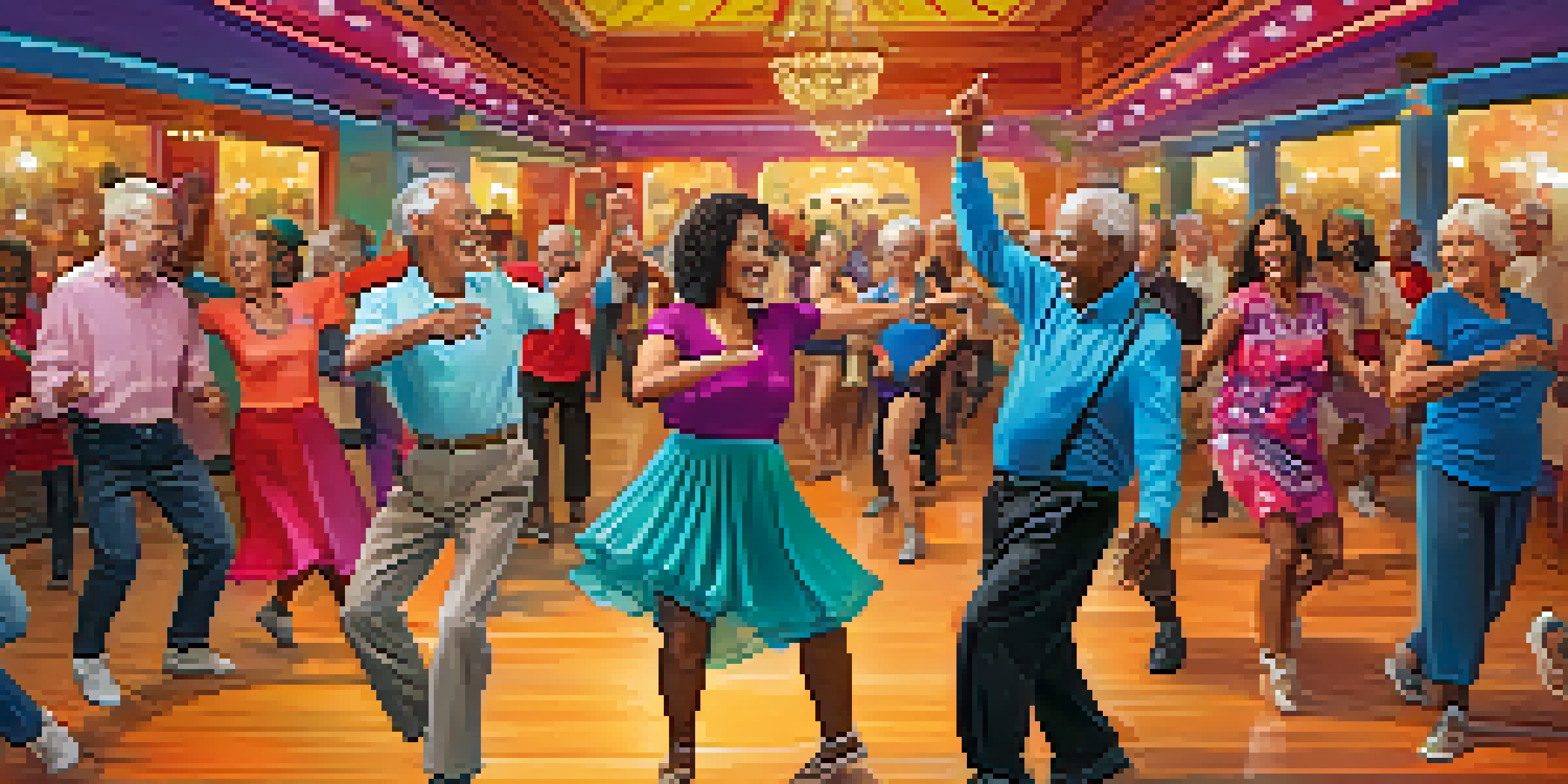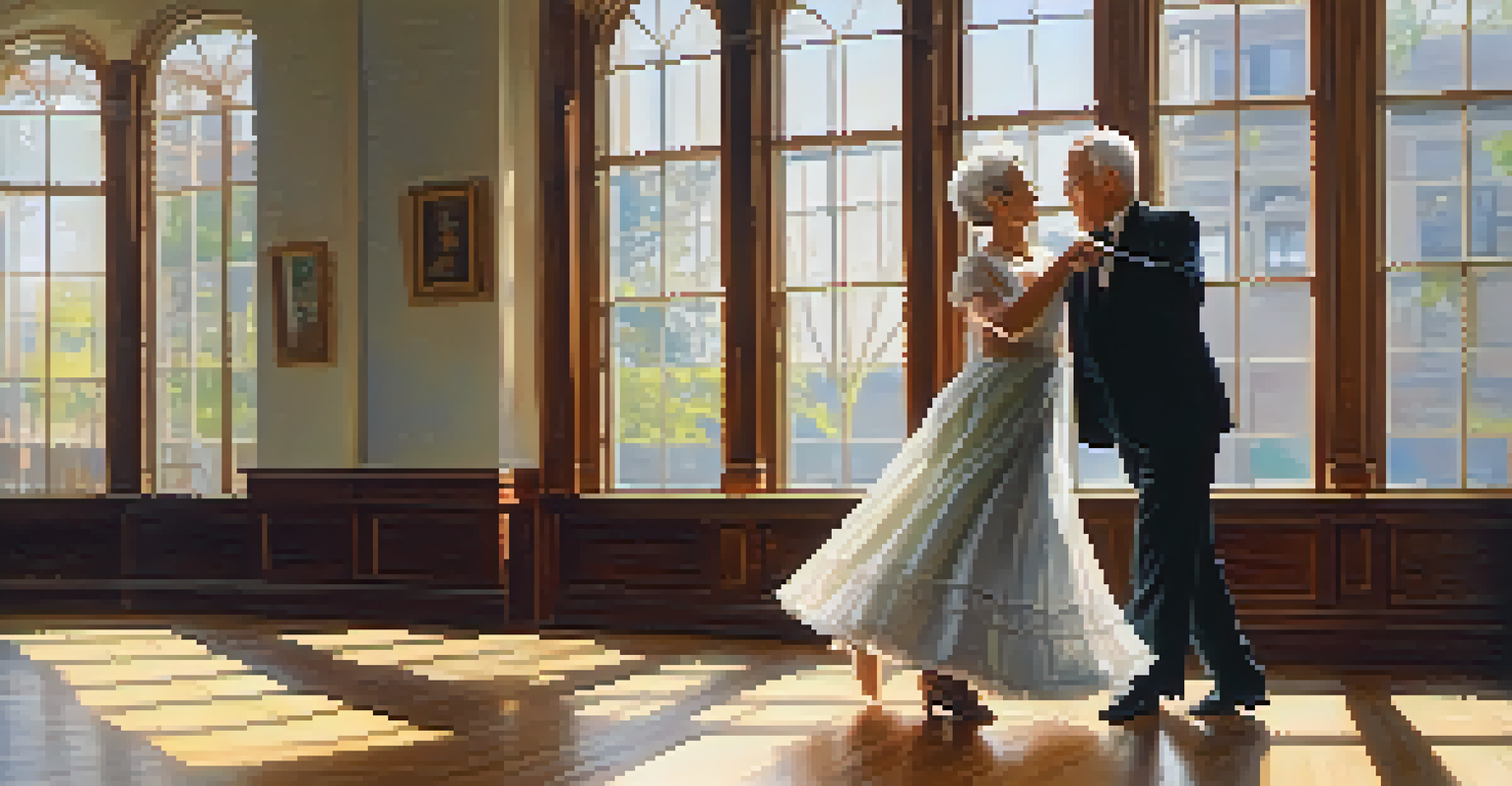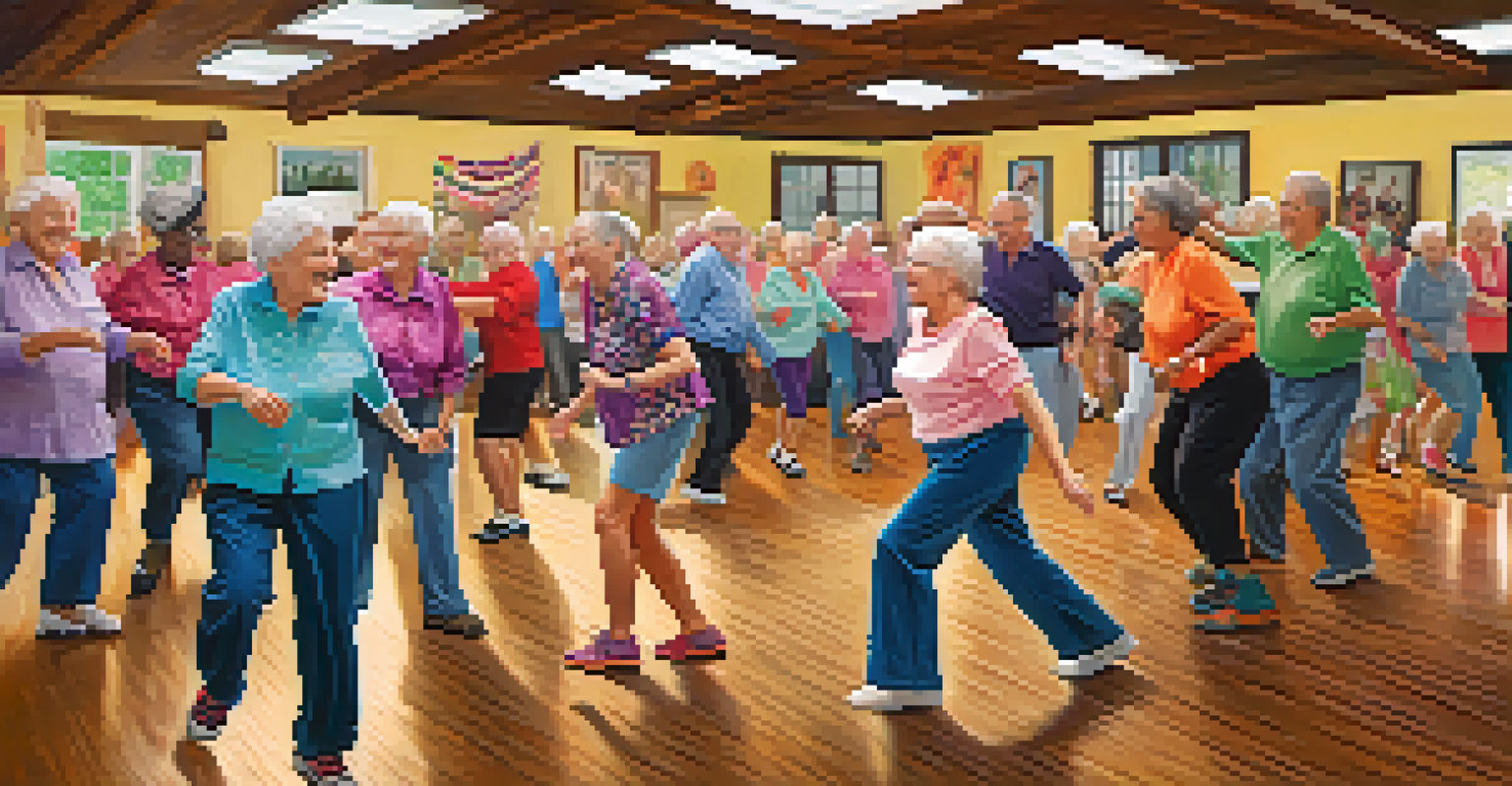Benefits of Dance Classes for Active Aging in Older Adults

Improved Physical Health Through Dance Classes
Dance classes are a fantastic way for older adults to improve their physical health. Engaging in dance helps enhance cardiovascular fitness, flexibility, and strength. Just like a gentle workout, the rhythmic movements keep the heart pumping and joints moving, making them feel more agile and lively.
Dance is the hidden language of the soul.
Moreover, the variety of dance styles—be it salsa, ballroom, or even line dancing—offers a fun way to stay active without the monotony of traditional exercise. This diversity caters to different interests and abilities, allowing everyone to find a style they love. For instance, a lively salsa class can elevate one's mood while providing an excellent workout.
Incorporating dance into a regular routine can lead to lasting health benefits, including better balance and coordination. These improvements can significantly reduce the risk of falls, which is a common concern in older adults. So not only do dance classes make you feel great, but they also contribute to a healthier and safer lifestyle.
Boosting Mental Well-Being with Dance Classes
The benefits of dance extend beyond physical health; they significantly enhance mental well-being as well. Dance classes provide a creative outlet that stimulates the brain, leading to improved cognitive function. Learning new steps and routines challenges the mind, making it sharper and more engaged.

Additionally, the joy of dancing releases endorphins, those feel-good hormones that naturally lift your spirits. Many participants often report feeling happier after a dance session, which is a lovely bonus to the physical exercise. For example, a simple waltz can transform a gloomy day into a bright one, igniting joy and positivity.
Dance Classes Boost Physical Health
Engaging in dance improves cardiovascular fitness, flexibility, and strength, making older adults feel more agile and lively.
Furthermore, dance serves as a powerful stress reliever, offering a break from daily worries. The combination of movement, music, and social interaction creates a delightful escape, helping older adults manage anxiety and depression effectively. With every step, the burdens of the day seem to melt away, leaving only happiness and vitality.
Social Connections Formed Through Dance Classes
One of the most delightful aspects of dance classes is the opportunity to socialize and form new friendships. For many older adults, isolation can be a significant issue, but dance brings people together in a joyful and supportive environment. It's easy to strike up conversations with fellow dancers, sharing laughs and experiences.
To watch us dance is to hear our hearts speak.
These social connections can lead to a stronger sense of community and belonging. For example, forming a dance group can result in regular meet-ups, fostering friendships that extend beyond the dance floor. This camaraderie not only enriches lives but also combats loneliness, a common challenge for seniors.
Moreover, participating in group classes encourages teamwork and cooperation. Whether it's learning a new routine or performing together, older adults can support each other, building lasting bonds through shared experiences. In this way, dance classes serve as a beautiful platform for connection and friendship.
Enhancing Cognitive Function with Dance Classes
Dancing isn’t just about moving to the beat; it also plays a significant role in enhancing cognitive function. Learning choreography requires focus and memory, which can help keep the brain active and engaged. This mental stimulation is crucial for seniors, as it aids in maintaining cognitive health.
Studies have shown that engaging in activities like dance can reduce the risk of cognitive decline and dementia. The rhythmic patterns and coordination needed in dance challenge the brain, promoting neuroplasticity—the brain's ability to form new connections. For instance, remembering dance moves can be as beneficial as solving puzzles.
Enhancing Mental Well-Being Through Dance
Dance classes provide a creative outlet that stimulates the brain, releases endorphins, and serves as an effective stress reliever.
Additionally, the social aspect of dance classes further stimulates the brain. Interacting with others while learning new skills provides rich experiences that keep the mind agile. In essence, dance is not just a physical activity; it's a brain booster that can lead to sharper thinking and better memory.
Boosting Confidence Through Dance Classes
Dance classes can be a powerful confidence booster for older adults. As they learn new skills and improve their dancing abilities, participants often find themselves feeling more self-assured. This newfound confidence can seep into other areas of their lives, making them more willing to take on challenges.
The supportive atmosphere in dance classes encourages individuals to express themselves freely. The excitement of mastering a new dance move or performing in front of others fosters a sense of accomplishment. For example, many dancers feel a rush of pride after successfully executing a difficult routine, which can be incredibly empowering.
Moreover, dance allows older adults to embrace their uniqueness and individuality. Each person's style and expression on the dance floor is different, celebrating diversity and personal flair. This acceptance helps cultivate a positive self-image, reminding everyone that they are capable and worthy of enjoyment.
Flexibility and Mobility Gained from Dance Classes
Another significant benefit of dance classes for older adults is the improvement in flexibility and mobility. Many dance styles incorporate stretches and movements that enhance joint range, making everyday activities easier and more enjoyable. This can lead to increased independence, allowing seniors to remain active in their daily lives.
As dancers practice various routines, they learn to move their bodies in different ways, which can alleviate stiffness and improve overall mobility. For instance, a gentle ballet class can help seniors achieve graceful movements that translate into better balance and coordination. The result is a body that feels more youthful and agile.
Building Social Connections via Dance
Dance classes foster friendships and community, combating loneliness and promoting teamwork among older adults.
Additionally, this increased flexibility can help reduce discomfort and pain in the body. Many older adults experience aches and stiffness, but regular dance practice can counteract these issues. By incorporating dance into their routines, seniors can relish the benefits of a more flexible and mobile lifestyle.
Creating a Joyful Routine with Dance Classes
Incorporating dance classes into an older adult's routine can create a joyful and fulfilling lifestyle. The excitement of attending a class, learning new dances, and meeting new people adds a spark to their day. This routine becomes something to look forward to, breaking the monotony of daily life.
Moreover, the rhythm and music involved in dance naturally uplift spirits, transforming exercise into a fun activity. Whether it’s a lively Zumba class or a slow-paced ballroom dance, the enjoyment of movement can lead to better adherence to fitness goals. It's hard not to smile when dancing to a favorite tune!

Establishing this joyful routine not only enhances physical wellness but also promotes mental and emotional health. It encourages older adults to stay active and engaged, creating a positive feedback loop of happiness and fulfillment. In essence, dance classes become a vital part of a vibrant and dynamic lifestyle.